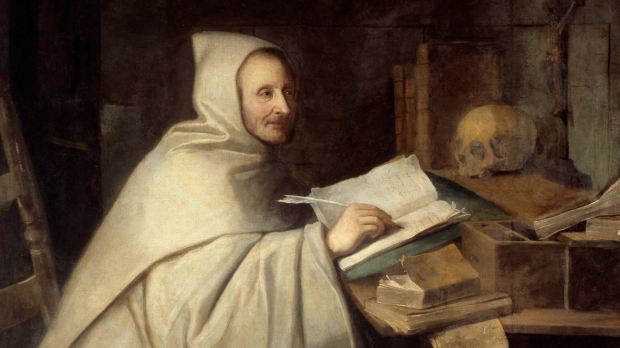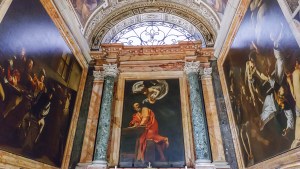Armand Jean Le Bouthillier de Rancé (1626-1700), abbot of a Trappist monastery, refused to have his portrait painted, out of humility. The Duke of Saint-Simon and painter Hyacinthe Rigaud decided to use trickery in order to immortalize the monk’s face.
The story takes place at Soligny-La-Trappe, northwestern France, in 1696. A beautiful light illuminates Abbot de Rancé’s study. The usual silence that reigns at the Abbey of La Trappe offers a studious and ideal calm. However, painter Hyacinthe Rigaud is restless. What possessed him to accept this job?
There was no lack of clients for Europe’s leading portraitist. The court and the nobility provided him with enough work. But here he is, disguised as an officer and about to pose as a stranger to observe a model who had no desire to be painted.
“Don’t worry,” says the Duke of Saint-Simon, his client. “I’ll take care of the conversation. You can concentrate on Abbot de Rancé.”
Mission almost impossible?
Rigaud must admit that the abbot of the Trappe monastery intrigues him. He must be very special if the Duke is ready to use trickery to immortalize this man.
All the painter knows about him is that he was the originator of the strict reforms of the Cistercian Order. This is surprising, given that the abbot had been wealthy and worldly in his youth, indulging in the pleasures of court life.
Yet thanks to him, the Trappe monastery (the origin of today’s Trappist monks) became an extraordinary place of virtue and prayer. The abbey attracted many ecclesiastics, and Abbot de Rancé is said to be an unparalleled theologian.
Perhaps that is why Rigaud had accepted: to have the chance to see this illustrious character who never leaves his abbey. Or perhaps it was the challenge of having to paint from memory alone. Whatever the case, he couldn’t back down.
The door finally opens and Rigaud stands up, holding his breath. The monk is a septuagenarian dressed in a white habit and a hood. He walks slowly, dragging behind him the weight of years. According to the duke, he hardly ever leaves the abbey’s infirmary. Yet his smile conveys an undeniable serenity.
“Father Abbot,” says the Duke, “this is the officer I told you about.” Rigaud in turn greets the abbot briefly, taking care to exaggerate his stammer. This is to serve as an alibi for him to be able to observe without having to speak, without raising suspicions.
While the duke and the abbot are engaged in conversation, Rigaud moves away somewhat to begin his observation. Abbot de Rancé’s face seems to transform as he speaks. The wisdom that emanates from him is not only that of an old man, but that of a philosopher. However, the old abbot’s words never refer to himself. Never before has Rigaud heard someone speak so well while speaking so little of himself.
A deception for a great work of art
The abbot’s features are in perfect harmony with his words. His smile shows the satisfaction of a life well lived. His wrinkles, on the other hand, show the sufferings and penances he has undergone in the course of his life. In his lively eyes shine the intelligence and presence of a beautiful soul. Rigaud knows already that they will be the hardest to reproduce.
The session lasts three quarters of an hour, as does that of the following day. The day after, it lasts only half an hour. After each visit, Rigaud focuses completely on his canvas, working to his heart’s content to reproduce this face, so expressive and rich in character.
If the abbot found the experience unusual, he gave no sign of it. Once the face was finished, Rigaud penciled in the body, using as a model another monk wearing the same habit, before returning to Paris to complete his portrait. The result moved the Duke of Saint-Simon to tears.
Rigaud completed the painting in 1697. He was so proud of it that he made several copies, despite the exclusivity requested by his client. The duke consoled himself by thinking that through these copies other people would get to know the illustrious and virtuous abbot.
Plagued with guilt, the Duke ended up confessing his deception to Abbot de Rancé in a letter. The latter answered him: “A certain emperor said he loved treason and hated traitors. I will content myself with hating treason and loving the traitor.”
It is Louis de Rouvroy, the Duke of Saint-Simon himself, who reported these facts in his Memoirs. The painting is now in the Abbey of La Trappe, in Soligny-la-Trappe.



